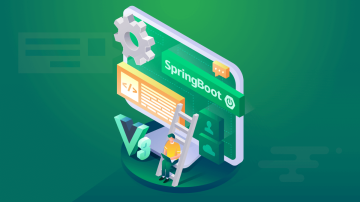SpringApplication是所有springboot的入口类,分析此类有助于我们了解springboot的工作机制。本文以2.0.3.REALEASE版本作分析
SpringApplication
调用实例如下
package com.example.demospringbootweb;import org.springframework.boot.SpringApplication;import org.springframework.boot.autoconfigure.SpringBootApplication;@SpringBootApplicationpublic class DemoSpringbootWebApplication { public static void main(String[] args) {
SpringApplication.run(DemoSpringbootWebApplication.class, args);
}
}调用的是SpringApplication.run()方法进行应用程序的启动。代码很简单也容易让用户上手,笔者这就进入其具体的类以探瑰宝。
注释描述
先看下其官方注释,有助于我们入门。由于注释过长,笔者此处只对其主要内容作下翻译总结
可以简单的通过main()函数来辅助启动一个spring应用程序。默认情况下其会按照以下步骤来辅助我们创建的应用
创建一个关联的ApplicationContext实例
注册CommandLinePropertySource实例暴露命令行的参数作为spring的属性
刷新ApplicationContext,并加载所有的单例beans
触发实现了CommandLineRunner的实例beans
SpringApplications可以读取来自不同源的beans。官方建议用户使用@Configuration注解相应的启动类,当然也支持从以下方式加载相应的beans
AnnotatedBeanDefinitionReader加载指定的类
XmlBeanDefinitionReader加载XML的配置信息或者GroovyBeanDefinitionReader加载groovy脚本资源
ClassPathBeanDefinitionScanner扫描指定的包加载相应bean
过于抽象,笔者继续通过源码来对上述的内容进行回顾
构造函数
/**
* Create a new {@link SpringApplication} instance. The application context will load
* beans from the specified primary sources (see {@link SpringApplication class-level}
* documentation for details. The instance can be customized before calling
* {@link #run(String...)}.
* @param resourceLoader the resource loader to use
* @param primarySources the primary bean sources
* @see #run(Class, String[])
* @see #setSources(Set)
*/
@SuppressWarnings({ "unchecked", "rawtypes" }) public SpringApplication(ResourceLoader resourceLoader, Class<?>... primarySources) { this.resourceLoader = resourceLoader; // 加载的主类,可指定多个
Assert.notNull(primarySources, "PrimarySources must not be null"); this.primarySources = new LinkedHashSet<>(Arrays.asList(primarySources)); // 推断是否为web环境
this.webApplicationType = deduceWebApplicationType(); // 加载ApplicationContextInitializer接口类
setInitializers((Collection) getSpringFactoriesInstances(
ApplicationContextInitializer.class)); // 加载ApplicationListener接口类
setListeners((Collection) getSpringFactoriesInstances(ApplicationListener.class)); // 推断主函数类
this.mainApplicationClass = deduceMainApplicationClass();
}对上述的注释作下简单的解释
SpringApplication#deduceWebApplicationType()
推断是否为web环境,源码如下
private WebApplicationType deduceWebApplicationType() { if (ClassUtils.isPresent(REACTIVE_WEB_ENVIRONMENT_CLASS, null)
&& !ClassUtils.isPresent(MVC_WEB_ENVIRONMENT_CLASS, null)) { return WebApplicationType.REACTIVE;
} for (String className : WEB_ENVIRONMENT_CLASSES) { if (!ClassUtils.isPresent(className, null)) { return WebApplicationType.NONE;
}
} return WebApplicationType.SERVLET;
}从代码层看总共有三种应用类型,也代表了三个环境类型
WebApplicationType.REACTIVE reactive web应用(classpath环境下须有org.springframework.web.reactive.DispatcherHandler)
WebApplicationType.SERVLET servlet web应用(classpath环境下存在javax.servlet.Servlet或者org.springframework.web.context.ConfigurableWebApplicationContext)
WebApplicationType.NONE 简单的JAVA应用(classpath环境不存在上述的类)
SpringApplication#deduceMainApplicationClass()
推断主函数类,源码如下
private Class<?> deduceMainApplicationClass() { try {
StackTraceElement[] stackTrace = new RuntimeException().getStackTrace(); for (StackTraceElement stackTraceElement : stackTrace) { if ("main".equals(stackTraceElement.getMethodName())) { return Class.forName(stackTraceElement.getClassName());
}
}
} catch (ClassNotFoundException ex) { // Swallow and continue
} return null;
}很简单,就是寻找哪个类下含有main方法,此处和我们常用的启动类不谋而合
SpringApplication#getSpringFactoriesInstances()
找寻相应的接口实现类,源码如下
private <T> Collection<T> getSpringFactoriesInstances(Class<T> type,
Class<?>[] parameterTypes, Object... args) { // 上下文classLoader
ClassLoader classLoader = Thread.currentThread().getContextClassLoader(); // 通过SpringFactoriesLoader来加载相应的类
Set<String> names = new LinkedHashSet<>(
SpringFactoriesLoader.loadFactoryNames(type, classLoader));
List<T> instances = createSpringFactoriesInstances(type, parameterTypes,
classLoader, args, names);
AnnotationAwareOrderComparator.sort(instances); return instances;
}进而查看相应的静态方法SpringFactoriesLoader.loadFactoryNames(),源码如下
public static List<String> loadFactoryNames(Class<?> factoryClass, @Nullable ClassLoader classLoader) {
String factoryClassName = factoryClass.getName(); // 关键处理类
return loadSpringFactories(classLoader).getOrDefault(factoryClassName, Collections.emptyList());
}关键处理类出来了,源码跟上
private static Map<String, List<String>> loadSpringFactories(@Nullable ClassLoader classLoader) { // 缓存处理
MultiValueMap<String, String> result = cache.get(classLoader); if (result != null) { return result;
} try { // 找寻所有classpath下的"META-INF/spring.factories"文件
Enumeration<URL> urls = (classLoader != null ?
classLoader.getResources(FACTORIES_RESOURCE_LOCATION) :
ClassLoader.getSystemResources(FACTORIES_RESOURCE_LOCATION));
result = new LinkedMultiValueMap<>(); while (urls.hasMoreElements()) {
URL url = urls.nextElement();
UrlResource resource = new UrlResource(url);
Properties properties = PropertiesLoaderUtils.loadProperties(resource); for (Map.Entry<?, ?> entry : properties.entrySet()) { // 对含有,的进行分隔并转为list集合
List<String> factoryClassNames = Arrays.asList(
StringUtils.commaDelimitedListToStringArray((String) entry.getValue()));
result.addAll((String) entry.getKey(), factoryClassNames);
}
}
cache.put(classLoader, result); return result;
} catch (IOException ex) { throw new IllegalArgumentException("Unable to load factories from location [" +
FACTORIES_RESOURCE_LOCATION + "]", ex);
}
}由此我们得出结论,classpath环境下所有含META-INF/spring.factories的文件,里面约定了默认的实现。笔者以spring-boot-2.0.3.REALEASE.jar为例
# PropertySource Loaders org.springframework.boot.env.PropertySourceLoader=\ org.springframework.boot.env.PropertiesPropertySourceLoader,\ org.springframework.boot.env.YamlPropertySourceLoader # Run Listeners org.springframework.boot.SpringApplicationRunListener=\ org.springframework.boot.context.event.EventPublishingRunListener # Error Reporters org.springframework.boot.SpringBootExceptionReporter=\ org.springframework.boot.diagnostics.FailureAnalyzers # Application Context Initializers org.springframework.context.ApplicationContextInitializer=\ org.springframework.boot.context.ConfigurationWarningsApplicationContextInitializer,\ org.springframework.boot.context.ContextIdApplicationContextInitializer,\ org.springframework.boot.context.config.DelegatingApplicationContextInitializer,\ org.springframework.boot.web.context.ServerPortInfoApplicationContextInitializer # Application Listeners org.springframework.context.ApplicationListener=\ org.springframework.boot.ClearCachesApplicationListener,\ org.springframework.boot.builder.ParentContextCloserApplicationListener,\ org.springframework.boot.context.FileEncodingApplicationListener,\ org.springframework.boot.context.config.AnsiOutputApplicationListener,\ org.springframework.boot.context.config.ConfigFileApplicationListener,\ org.springframework.boot.context.config.DelegatingApplicationListener,\ org.springframework.boot.context.logging.ClasspathLoggingApplicationListener,\ org.springframework.boot.context.logging.LoggingApplicationListener,\ org.springframework.boot.liquibase.LiquibaseServiceLocatorApplicationListener # Environment Post Processors org.springframework.boot.env.EnvironmentPostProcessor=\ org.springframework.boot.cloud.CloudFoundryVcapEnvironmentPostProcessor,\ org.springframework.boot.env.SpringApplicationJsonEnvironmentPostProcessor,\ org.springframework.boot.env.SystemEnvironmentPropertySourceEnvironmentPostProcessor # Failure Analyzers org.springframework.boot.diagnostics.FailureAnalyzer=\ org.springframework.boot.diagnostics.analyzer.BeanCurrentlyInCreationFailureAnalyzer,\ org.springframework.boot.diagnostics.analyzer.BeanNotOfRequiredTypeFailureAnalyzer,\ org.springframework.boot.diagnostics.analyzer.BindFailureAnalyzer,\ org.springframework.boot.diagnostics.analyzer.BindValidationFailureAnalyzer,\ org.springframework.boot.diagnostics.analyzer.UnboundConfigurationPropertyFailureAnalyzer,\ org.springframework.boot.diagnostics.analyzer.ConnectorStartFailureAnalyzer,\ org.springframework.boot.diagnostics.analyzer.NoUniqueBeanDefinitionFailureAnalyzer,\ org.springframework.boot.diagnostics.analyzer.PortInUseFailureAnalyzer,\ org.springframework.boot.diagnostics.analyzer.ValidationExceptionFailureAnalyzer,\ org.springframework.boot.diagnostics.analyzer.InvalidConfigurationPropertyNameFailureAnalyzer,\ org.springframework.boot.diagnostics.analyzer.InvalidConfigurationPropertyValueFailureAnalyzer # FailureAnalysisReporters org.springframework.boot.diagnostics.FailureAnalysisReporter=\ org.springframework.boot.diagnostics.LoggingFailureAnalysisReporter
因此SpringApplication构造函数中加载的ApplicationContextInitializer类有如下
ConfigurationWarningsApplicationContextInitializer (对ComponentScan指定的值为"org"等进行报警输出)
ContextIdApplicationContextInitializer (创建默认名为application的ContextId对象,也可通过spring.application.name指定)
DelegatingApplicationContextInitializer (对context.initializer.classes指定的class集合进行加载)
ServerPortInfoApplicationContextInitializer (将local.server.port设置为指定的web端口,默认为8080)
而加载的ApplicationListener类有如下
ClearCachesApplicationListener (反射工具缓存清空事件)
ParentContextCloserApplicationListener (父ApplicationContext关闭事件)
FileEncodingApplicationListener (系统变量配置的file.encoding值是否与环境变量spring.mandatory-file-encoding一致事件)
AnsiOutputApplicationListener (控制台彩色输出事件,可通过spring.output.ansi.enabled来指定)
ConfigFileApplicationListener (读取spring.profile.active/spring.profile.include配置)
DelegatingApplicationListener (委托事件处理类)
ClasspathLoggingApplicationListener (打印classpath信息,级别为debug)
LoggingApplicationListener (日志处理事件)
LiquibaseServiceLocatorApplicationListener (classpath是否存在liquibase的CustomResolverServiceLocator类判断事件)
小结
由此SpringApplication构造函数完成了一些必要的初始化,重点在于ApplicationContextInitializer和ApplicationListener接口类。并且通过构造函数反射来进行实例化
限于篇幅过长,笔者将对SpringApplication#run()方法的具体解析放于下一章节来分析
作者:南柯问天 出处:http://www.cnblogs.com/question-sky/ 本文版权归本人和博客园共有,欢迎转载,但未经作者同意必须保留此段声明,且在文章页面明显位置给出原文连接,否则保留追究法律责任的权利。
原文出处:http://www.cnblogs.com/question-sky/p/9366500.html

 随时随地看视频
随时随地看视频




